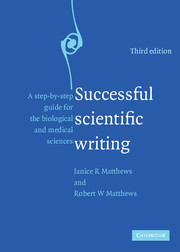Book contents
- Frontmatter
- Contents
- Preface
- Preface to the third edition
- 1 PREPARING TO WRITE
- 2 COMPOSING A FIRST DRAFT
- 3 VISUAL SUPPORT FOR THE WRITTEN WORD
- 4 VISUAL SUPPORT FOR THE SPOKEN WORD
- 5 REVISING TO INCREASE COHERENCE
- 6 IMPROVING WORD CHOICE, AND SYNTAX STYLE
- 7 ATTENDING TO GRAMMAR, NUMBERS, AND OTHER MECHANICS
- 8 THE REST OF THE STORY
- Appendix 1 Suggested responses to exercises
- Appendix 2 Excerpts from “Uniform requirements for manuscripts submitted to biomedical journals: Writing and editing for biomedical publication”
- Selected resources
- Index
Appendix 1 - Suggested responses to exercises
- Frontmatter
- Contents
- Preface
- Preface to the third edition
- 1 PREPARING TO WRITE
- 2 COMPOSING A FIRST DRAFT
- 3 VISUAL SUPPORT FOR THE WRITTEN WORD
- 4 VISUAL SUPPORT FOR THE SPOKEN WORD
- 5 REVISING TO INCREASE COHERENCE
- 6 IMPROVING WORD CHOICE, AND SYNTAX STYLE
- 7 ATTENDING TO GRAMMAR, NUMBERS, AND OTHER MECHANICS
- 8 THE REST OF THE STORY
- Appendix 1 Suggested responses to exercises
- Appendix 2 Excerpts from “Uniform requirements for manuscripts submitted to biomedical journals: Writing and editing for biomedical publication”
- Selected resources
- Index
Summary
CHAPTER 1
Exercise 1.1. Search strategy and Boolean logic (page 10)
A, H, J
B, E, G
D, F
A, B, D, E, F, G, H, J
F
C, I
Exercise 1.2. Message, format, and audience (page 19)
Probably not. Simple novelty or extension of a previous record usually is not enough to warrant publication. A case study must change, improve, or enlarge how people think.
The paper your colleague has proposed would have a purpose – to report the case findings – but as a research paper it would not have a message. However, a critical review of case records, coupled with a careful and critical assessment of the literature, might result in a valuable document. A case-series analysis or review article would help busy clinicians get information without laboriously sifting through the primary literature. It would tell investigators where things stand on particular aspects of the disease. And, if well written, it could suggest directions new research should take.
Yes, with proper choice of format. Written as a “me-too” series of case histories, the paper will probably be rejected. However, a case-series analysis that would include these data could be a useful contribution.
Only one primary research publication is justifiable, because all of the results bear upon your single message. However, this could be supplemented with general articles written for the popular press to reach other target audiences.
Psychological researchers, clinicians, psychologists, teachers, school administrators, parents.
- Type
- Chapter
- Information
- Successful Scientific WritingA Step-by-Step Guide for the Biological and Medical Sciences, pp. 209 - 220Publisher: Cambridge University PressPrint publication year: 2007



